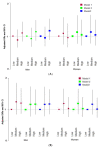Inverse Association of the Adequacy and Balance Scores in the Modified Healthy Eating Index with Type 2 Diabetes in Women
- PMID: 37049581
- PMCID: PMC10097397
- DOI: 10.3390/nu15071741
Inverse Association of the Adequacy and Balance Scores in the Modified Healthy Eating Index with Type 2 Diabetes in Women
Abstract
Type 2 diabetes (T2DM) has markedly increased among Asians as their diets and lifestyles become more westernized. We, therefore, investigated the hypothesis that the Korean healthy eating index (KHEI) scores are associated with gender-specific T2DM risk in adults. The hypothesis was tested using the data from the Korea National Health and Nutrition Examination Survey-VI (2013-2017) with a complex sample survey design. Along with the KHEI scores, the modified KHEI (MKHEI) scores for the Korean- (KSD) and Western-style diets (WSD) were used as independent parameters, calculated using a validated semi-quantitative food-frequency questionnaire (SQFFQ). We estimated the association between the KHEI or MKHEI and the T2DM risk using logistic regression after adjusting for T2DM-related covariates. The adults with T2DM were more frequently older men who were less educated, married, on a lower income, and living in rural areas compared to those without T2DM. Not only the fasting serum glucose concentrations but also the waist circumferences and serum triglyceride concentrations were much higher in adults with T2DM than in those without T2DM in both genders. Serum HDL concentrations in the non-T2DM subjects exhibited a greater inverse relationship to serum glucose than in the T2DM group in both genders. Twenty-four-hour recall data revealed that women, but not men, had higher calcium, vitamin C, saturated and monounsaturated fatty acids, retinol, and vitamin B2 intakes than the T2DM group. Furthermore, overall, the KHEI score and the adequacy and balance scores among its components were significantly higher in the non-T2DM group than in the T2DM group, but only in women. The KHEI scores were inversely associated with T2DM only in women. The mixed grain intake score was higher in the non-T2DM than the T2DM group only in men. However, there were no differences between the groups in the MKHEI scores for KSD and WSD. In conclusion, high KHEI scores in the adequacy and balance components might prevent and/or delay T2DM risk, but only in women.
Keywords: calcium; health eating index; noodles; type 2 diabetes; vitamin C.
Conflict of interest statement
The authors have no potential conflict of interest.
Figures



Similar articles
-
A Healthy Diet Rich in Calcium and Vitamin C Is Inversely Associated with Metabolic Syndrome Risk in Korean Adults from the KNHANES 2013-2017.Nutrients. 2021 Apr 16;13(4):1312. doi: 10.3390/nu13041312. Nutrients. 2021. PMID: 33923450 Free PMC article.
-
Association Between Korean-Style Balanced Diet and Risk of Abdominal Obesity in Korean Adults: An Analysis Using KNHANES-VI (2013-2016).Front Nutr. 2022 Jan 20;8:772347. doi: 10.3389/fnut.2021.772347. eCollection 2021. Front Nutr. 2022. PMID: 35127781 Free PMC article.
-
Association of the Healthy Eating Index with Estimated Cardiovascular Age in Adults from the KNHANES 2013-2017.Nutrients. 2020 Sep 23;12(10):2912. doi: 10.3390/nu12102912. Nutrients. 2020. PMID: 32977614 Free PMC article.
-
Development of the Korean Healthy Eating Index for adults, based on the Korea National Health and Nutrition Examination Survey.Nutr Res Pract. 2022 Apr;16(2):233-247. doi: 10.4162/nrp.2022.16.2.233. Epub 2021 Aug 30. Nutr Res Pract. 2022. PMID: 35392533 Free PMC article.
-
Association Between Healthy Dietary Patterns and Chronic Kidney Disease in Patients with Diabetes: Findings from Korean National Health and Nutrition Examination Survey 2019-2021.Nutrients. 2025 May 7;17(9):1600. doi: 10.3390/nu17091600. Nutrients. 2025. PMID: 40362909 Free PMC article.
Cited by
-
Temporary Employment Is Associated with Poor Dietary Quality in Middle-Aged Workers in Korea: A Nationwide Study Based on the Korean Healthy Eating Index, 2013-2021.Nutrients. 2024 May 14;16(10):1482. doi: 10.3390/nu16101482. Nutrients. 2024. PMID: 38794720 Free PMC article.
References
-
- Lee H., Lee M., Park G., Khang A. Prevalence of Chronic Diabetic Complications in Patients with Type 2 Diabetes Mellitus: A Retrospective Study Based on the National Health Insurance Service-National Health Screening Cohort in Korea, 2002~2015. Korean J. Adult Nurs. 2022;34:39–50. doi: 10.7475/kjan.2022.34.1.39. - DOI
-
- Zhu D., Dwyer J.T., Ouyang C.-M. Type 2 Diabetes Mellitus in China: Risk Factors and Challenges. Nutr. Today. 2020;55:304–312. doi: 10.1097/NT.0000000000000451. - DOI
-
- Muilwijk M., Nicolaou M., Qureshi S.A., Celis-Morales C., Gill J.M.R., Sheikh A., Sattar N., Beune E., Jenum A.K., Stronks K., et al. Dietary and physical activity recommendations to prevent type 2 diabetes in South Asian adults: A systematic review. PLoS ONE. 2018;13:e0200681. doi: 10.1371/journal.pone.0200681. - DOI - PMC - PubMed
MeSH terms
Substances
Grants and funding
LinkOut - more resources
Full Text Sources
Medical

